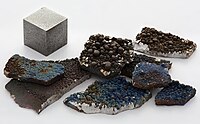
Photo from wikipedia
Abstract The photoluminescence (PL) properties of various Mn4+-activated fluoride phosphors are reviewed. The phosphors discussed are of I2−IV−F6:Mn4+ (I = alkali element; IV = tetravalent element), II−IV−F6:Mn4+ (II = divalent… Click to show full abstract
Abstract The photoluminescence (PL) properties of various Mn4+-activated fluoride phosphors are reviewed. The phosphors discussed are of I2−IV−F6:Mn4+ (I = alkali element; IV = tetravalent element), II−IV−F6:Mn4+ (II = divalent element), Ix−III−F3+x:Mn4+ (III = trivalent element), I3−IV−F7:Mn4+, Ix−V−F5+x:Mn4+ (V = pentavalent element), and II5−III−F13:Mn4+ types. The zero-phonon line (ZPL) emission and absorption transition energies of Mn4+ ions are determined from the experimental PL and PL excitation spectra by Franck−Condon analysis within the configurational-coordinate (CC) model. These energy values are used to obtain more reliable crystal-field (Dq) and Racah parameters (B and C) of the Mn4+ ions doped in various fluoride phosphors. Brik's new nephelauxetic parameter β1 is used to explain the relation of the ZPL emission energy [E(2Eg)ZPL] and crystal-field parameters to be written as E(2Eg)ZPL = 9.94 × 103β1 + 5.37 × 103 cm−1. Temperature dependence of the PL intensity is also analyzed based on the CC model and found to be in excellent agreement with the experimental data when we take into consideration the acoustic-phonon contribution term in our originally developed model.
Journal Title: Journal of Luminescence
Year Published: 2018
Link to full text (if available)
Share on Social Media: Sign Up to like & get
recommendations!